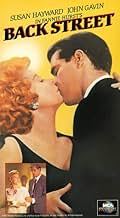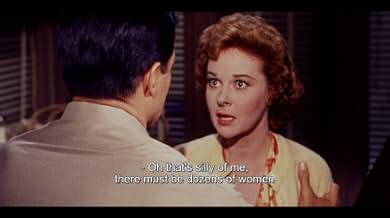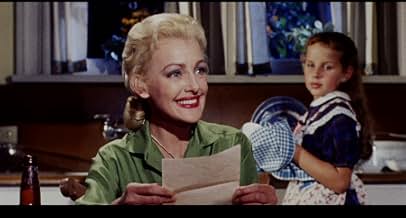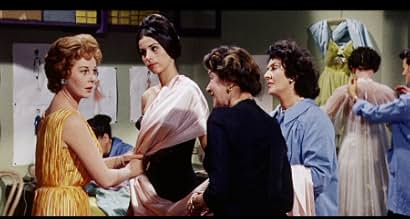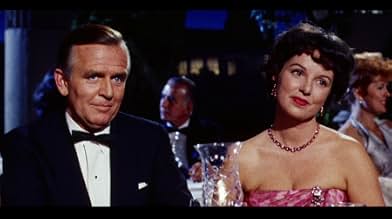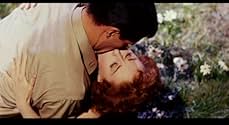NOTE IMDb
6,6/10
1,4 k
MA NOTE
L'histoire d'amour entre l'ambitieuse Rae Smith et l'élégant Paul Saxon débute au moment où celui-ci part à la guerre. Elle durera plusieurs années.L'histoire d'amour entre l'ambitieuse Rae Smith et l'élégant Paul Saxon débute au moment où celui-ci part à la guerre. Elle durera plusieurs années.L'histoire d'amour entre l'ambitieuse Rae Smith et l'élégant Paul Saxon débute au moment où celui-ci part à la guerre. Elle durera plusieurs années.
- Réalisation
- Scénario
- Casting principal
- Nommé pour 1 Oscar
- 1 nomination au total
Joseph Cronin
- Airport Clerk
- (as Joe Cronin)
Avis à la une
Many of the past reviewers of BACK STREET make good points in their comments on the film, stressing its clichés, its contrivances, its lack of real sincerity and emotion. Although I can see these points here and there, I have been hooked to this film ever since I saw it as a teenager, in the early sixties. Does this attraction have to do with the story itself? For me it does, no matter how rehashed it may be. Does it have to do with the characters? Yes, no matter how trite and unoriginal they may be. Does it have to do with the actors? CERTAINLY, especially Susan Hayward, an actress I admire profoundly, who is capable of keeping my attention as few others can, and who always dazzles with with her technique and capacity to be true, no matter how trashy the material originally is. Of course, BACK STREET owes a lot to its production values, the cinematography, the sets and gowns, but the motive of my attraction lies somewhere else, and it must be deep in myself, an area that was already sensitive to the film's values when I first saw it as a boy of 13.
Third movie-version of the Fannie Hurst novel, following successful adaptations in 1932 and 1941, this time with the glossy and unmistakable Ross Hunter touch. Susan Hayward is hardly a "back street gal" here, she's a would-be dress designer from Lincoln, Nebraska who has a meet-cute with returning soldier (and married man) John Gavin, apparently the sole heir to a department store chain. It takes a few reels to get these two together, but in the meanwhile our heroine goes to New York and then to Rome as the assistant to one of the top fashion designers in the world. Once Gavin catches up to her in Paris--and the gossip hits the fan--audiences can clearly see how dated this plot has become: a sharp, successful businesswoman wouldn't be shamed by her extra-marital affair, she'd be applauded! It isn't believable in the slightest, though producer Ross Hunter's penchant for luxurious suffering reaches almost an unparalleled peak here. The only thing Hunter can't quite fix is the chemistry between Hayward and Gavin; the stars have a comfortable, kiss-on-the-forehead type of love relationship (no big sparks), while Susan treats smitten Charles Drake so badly he completely vanishes from the scene! Vera Miles is a hoot as Gavin's alcoholic wife ("I almost forgot we had kids!"), while the screenplay pulls one astounding melodramatic event after another from its hat. For lovers of these woozy romantic pleasures, "Back Street" would be hard to top. *** from ****
Wow....this is Susan Hayward and John Gavin at their best! If you must have an extra-marital affair...they show us how it's done!!! Real class, however, not without it's drawbacks, when children are involved. This will have you grabbing for the giant Kleenex box at the end. This version is a must have for you classic collectors,because it's much better than the old 1941 black & white. Fannie Hurst sure could write these teary classics, and it's too bad there aren't writers around like her anymore. You knew there was plenty of sex in this movie but it wasn't thrown in your face, and absolutely no profanity!!! Thank God, you don't even miss it... which makes it all the more intriguing!!
Even in 1961, this had to be taken as a parody of the plush, woman's picture genre. The story had already been filmed in 1932 and 1941, and was creaky by any standard. All the deluxe Ross Hunter trappings (gowns by Jean Louis, jewels by Alexandre) are even more inflated here, with Hayward's gowns designed to match the drapes in the background. The overblown extravagance of the whole production makes Hunter's epics with Lana Turner look like second-string, double feature fare. Oscar-winner Hayward began her descent into strictly camp territory with this warhorse of a soaper; 1963's "Stolen Hours" (a remake of the Bette Davis classic, "Dark Victory") and 1964's "Where Love Has Gone" (co-starring Davis!) continued the trend, until it culminated in Hayward's (indeed, the world's) pinnacle of trash, "Valley of the Dolls" (1967). But back to "Back Street." The well-worn story concerns Hayward, an impossibly chic fashion designer, who is in love with the impossibly handsome (and improbably wooden) John Gavin, a married department store heir. Gavin's wife happens to be rip-roaring alcoholic Vera Miles, who is prone to falling down drunk at parties and threatening suicide. Hayward is nobly self-sacrificing, content to be the "back street" woman for the sake of Gavin's children (who are played by utterly resistible tots). That is, until Miles becomes one of Hayward's couture clients! This is the kind of loopy film where Hayward goes from being a scrappy little dressmaker to world famous couturier in, oh, ten minutes; where elaborate scenes are set up solely to showcase Jean Louis' scrumptious creations (they have no plot bearing whatsoever); and where John Gavin is somehow allowed to play his Really! Big! Scene! as if he's had a full frontal lobotomy (of course, he's so damned gorgeous, you really don't care). Oddly enough, Miles walks off with the film--her teeth are so firmly set into the scenery, you couldn't remove her if you tried, unless you wanted to pull back a bloody stump. (Lana Turner would never have let a supporting player upstage her show!) Hayward clearly took note to never let that happen again, and would give nothing but nostril-flaring, eye-bugging performances for the balance of her career. Look also for Natalie "Lovey Howell" Moorehead in a small but hilarious role as one of Hayward's gossipy clients. As swoony as all this is, "Back Street" is perfect lowbrow entertainment with highbrow trappings, and a sad reminder that, once upon a time, Hollywood DID make stuff like this--when even "bad" movies at least had a healthy shot of glamour to make them enjoyable.
When first released some forty years ago, critics rightly complained about the soap-opera plot, the melodramatic dialog, the stock characters, and the excessive showcasing of sets and costumes. These complaints are still valid, but over the course of four decades, a realization has emerged that despite or even because of these failings, "Back Street" is a gloriously entertaining work that plays just as well now as it did back in 1961. How many other movies can claim this sort of durability? I would, however, like to point out five faults in the production. (1) Susan Hayward is a good ten or even fifteen years too old for this part. (2) The film's supposed message about the emptiness of being the "other woman" is blunted by the opulent success in which Hayward lives. (3) Vera Miles' character is so selfish and shrewish that one can't imagine why John Gavin ever married her. There should have been a line about how he'd been forced into an "arranged" marriage in order to save the family business. (4) When Gavin and Hayward meet for the first time in New York, after their initial encounter in Nebraska, he seems surprised to learn that she's now the famous fashion-designer who signs her creations "rae" -- all small letters, very chic -- even though she'd specifically told him of her plans at their first meeting. How many fashion-designers named "rae" did he think there were in the world? (5) One must wait more than forty minutes before Gavin takes his shirt off, and then he just has a dimly-lit scene where he and Hayward run out of the ocean in modest swim-wear before reclining on a beach towel. Gavin's physique deserved much more exposure than this.
Le saviez-vous
- AnecdotesA clip of Rae saying goodbye to Paul the marine is featured at the beginning of Stevie Wonder's "Part-Time Lover" music video as a couple watches "Back Street" on TV.
- GaffesAfter Rae's confrontation with Paul's son, she drives out to the country house and turns off the paved road onto a dirt road. But, in the next shot, the rear-screen projection still shows the paved road.
- Citations
Paul Saxon: [presenting her with a framed portrait of himself] Do you think you can build a room around that?
Rae Smith: Why not? I've built a life around it.
- ConnexionsFeatured in The Universal Story (1996)
- Bandes originalesSymphony No. 4 in E minor I. Allegro non troppo
Composed by Johannes Brahms
Meilleurs choix
Connectez-vous pour évaluer et suivre la liste de favoris afin de recevoir des recommandations personnalisées
- How long is Back Street?Alimenté par Alexa
Détails
- Durée1 heure 47 minutes
- Rapport de forme
- 1.85 : 1
Contribuer à cette page
Suggérer une modification ou ajouter du contenu manquant

Lacune principale
By what name was Histoire d'un amour (1961) officially released in India in English?
Répondre
